Abstract
Subpopulations of lymphocytes in the broncho-alveolar air spaces of normal human lungs were compared with those in peripheral blood. Bone marrow-derived (bursal-equivalent) cells (B cells) were identified by complement receptors (EAC rosettes) and by surface immunoglobulin. Thymus-derived lymphocytes (T cells) were identified by their proliferative response to mitogens and the E rosette technique. Cells in lung air spaces were recovered from eight healthy nonsmoking volunteers by segmental lavage with the flexible bronchofiberscope. On the average, macrophages constituted 78% and lymphocytes 17% of the cells in the aspirates. B cells detected by surface immunoglobulin and complement receptors equaled 22% and 15% of lung lymphocytes, respectively. The distribution of lung B cells into heavy chain immunoglobulin classes revealed IgM and IgG to be the predominant classes, with mean values of 14.5% and 9.3%, respectively; the corresponding value for IgA was 5%. A comparable order of frequency (IgM greater than IgG greater than IgA) was observed for purified peripheral blood lymphocytes in the same and other control subjects. T cells comprised the majority (47%) of identifiable lung lymphocytes by the E rosette method. The presence of lung T cells was also corroborated by their proliferative response to mitogens (phytohemagglutinin and concanavallin A), but the response was less than that of equal numbers of peripheral blood lymphocytes from the same subjects. The B/T cell ratio for lung lymphocytes was comparable to results with peripheral blood lymphocytes in the same subjects, but a higher proportion of lung lymphocytes could not be identified as either T or B cells. It is postulated that lung lymphocytes participate in the local immune defenses of the lung.
Full text
PDF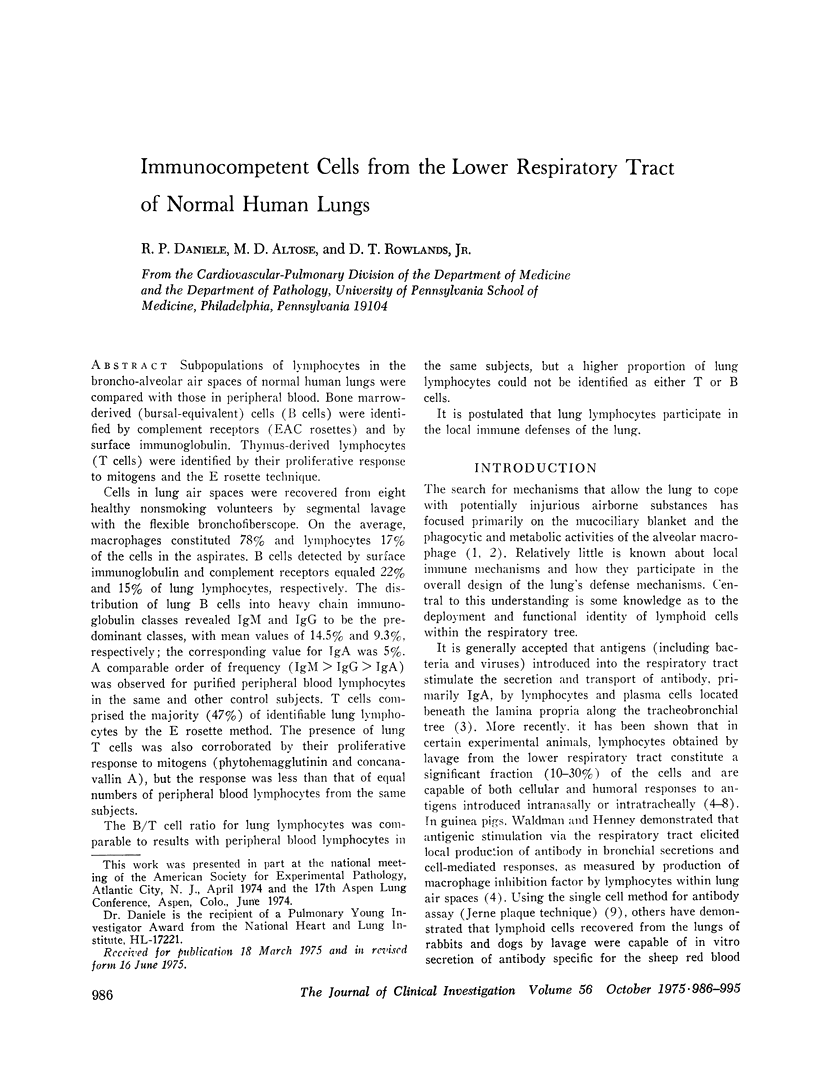
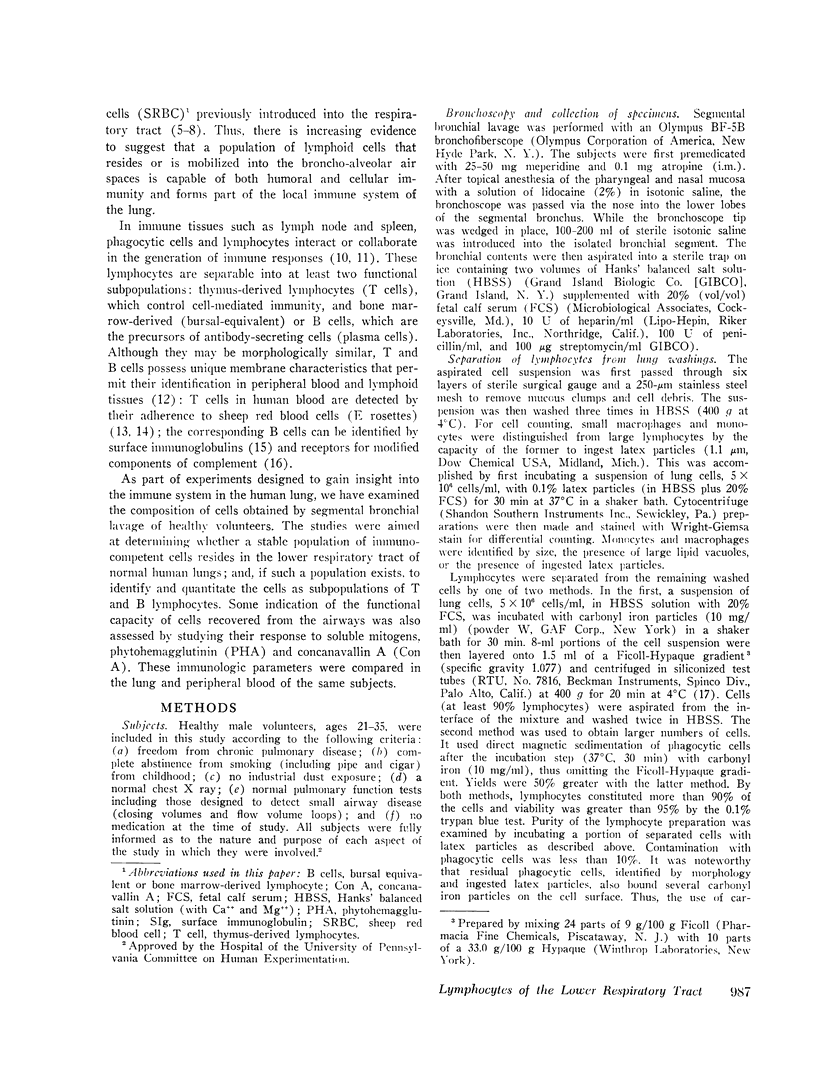
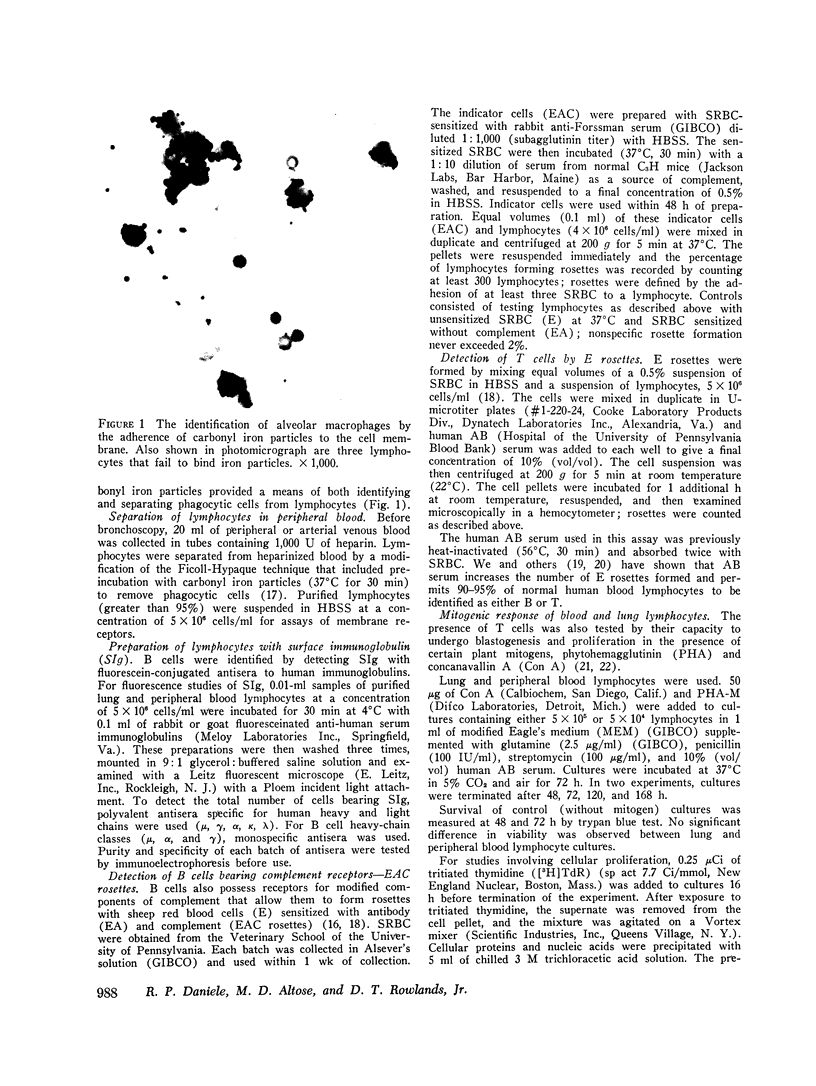
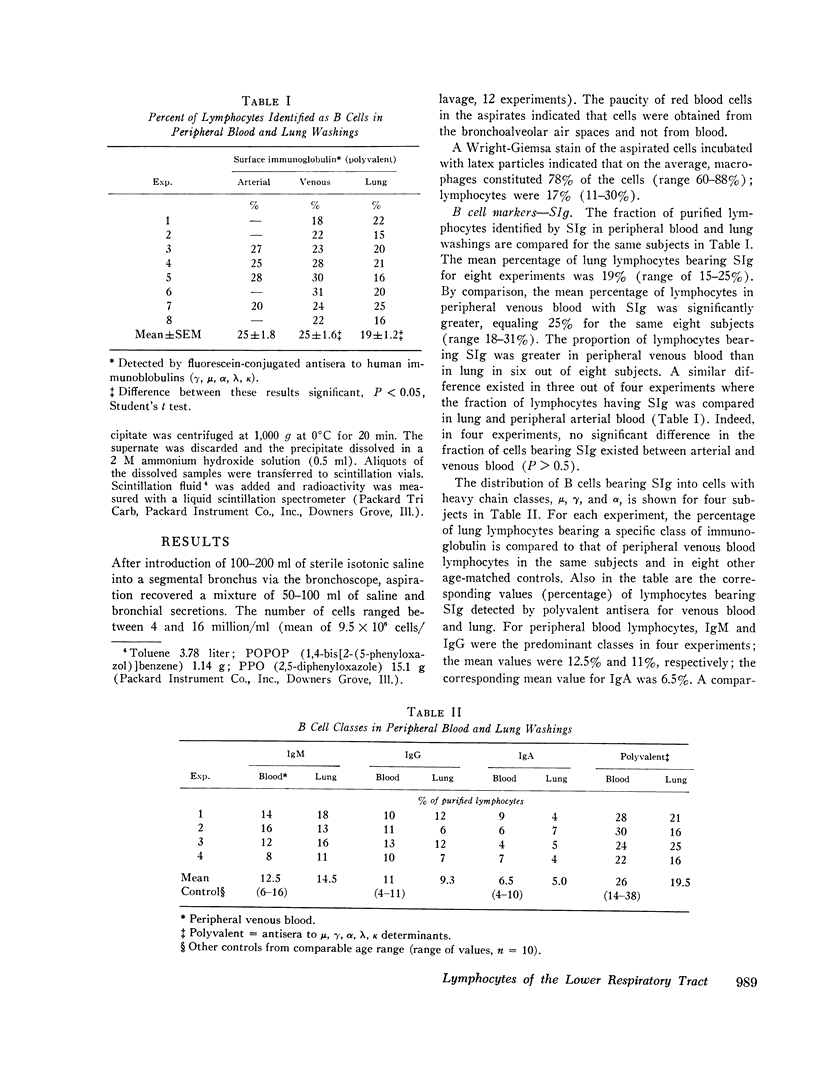
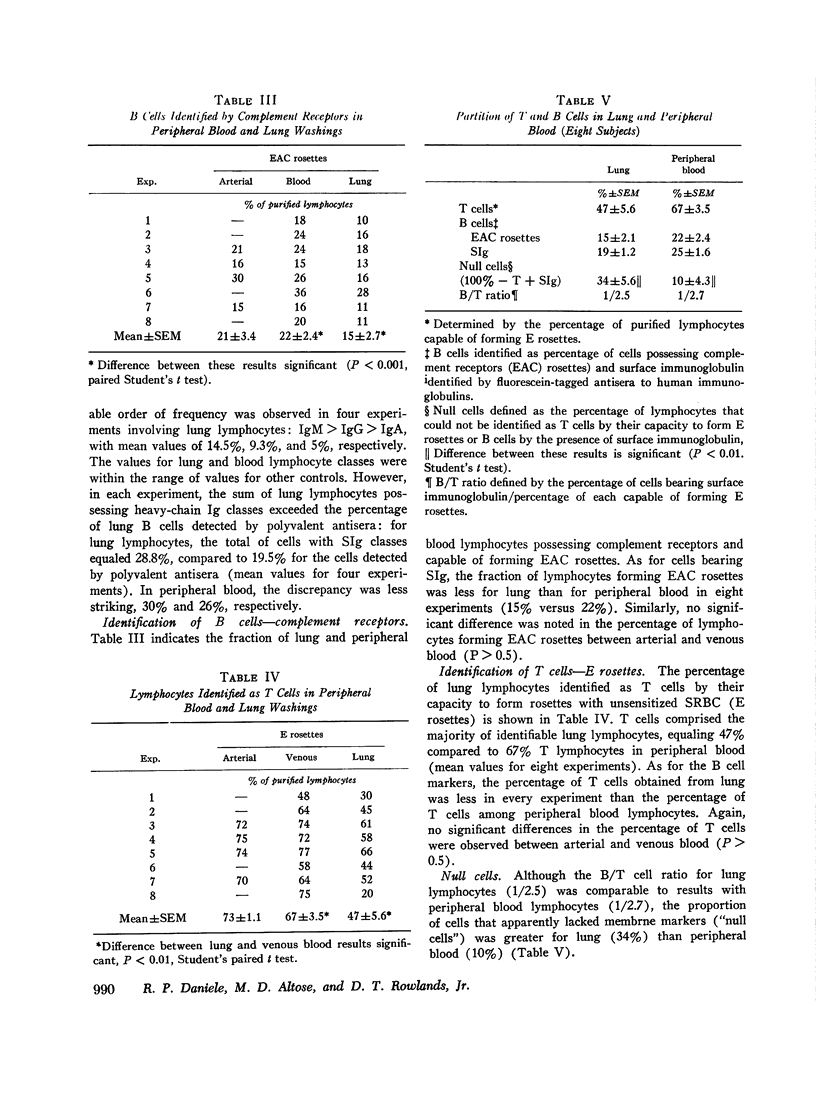
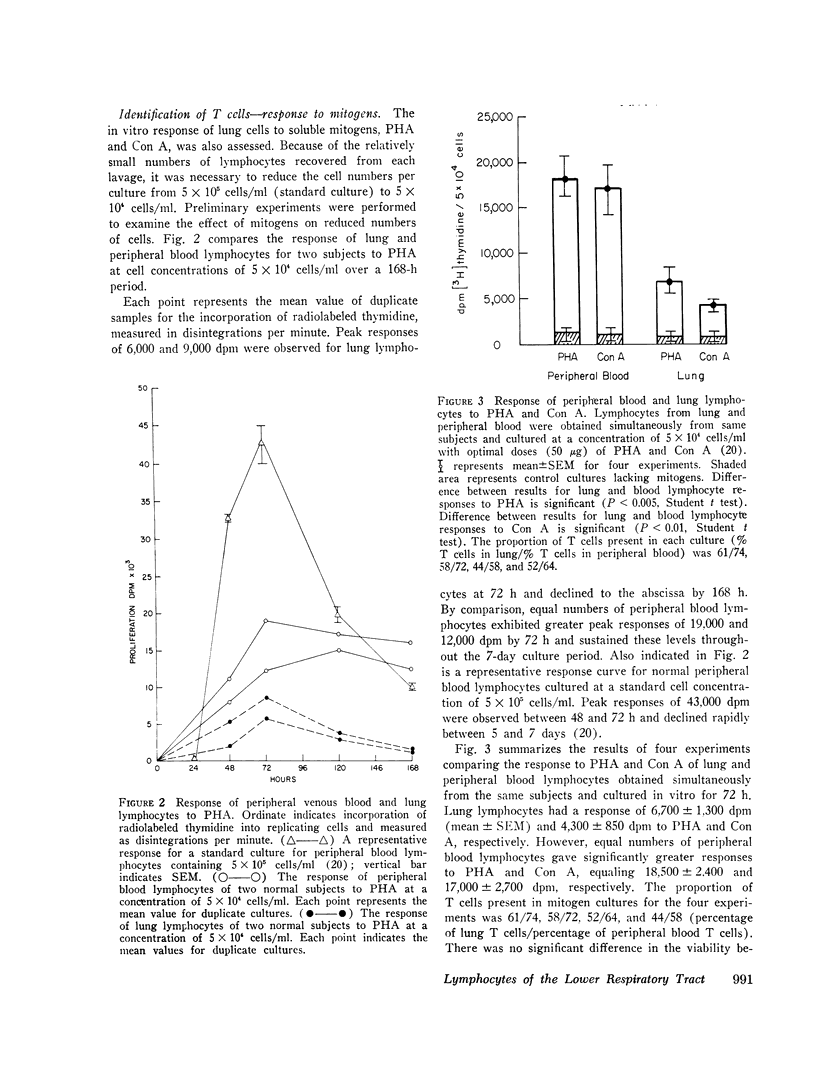
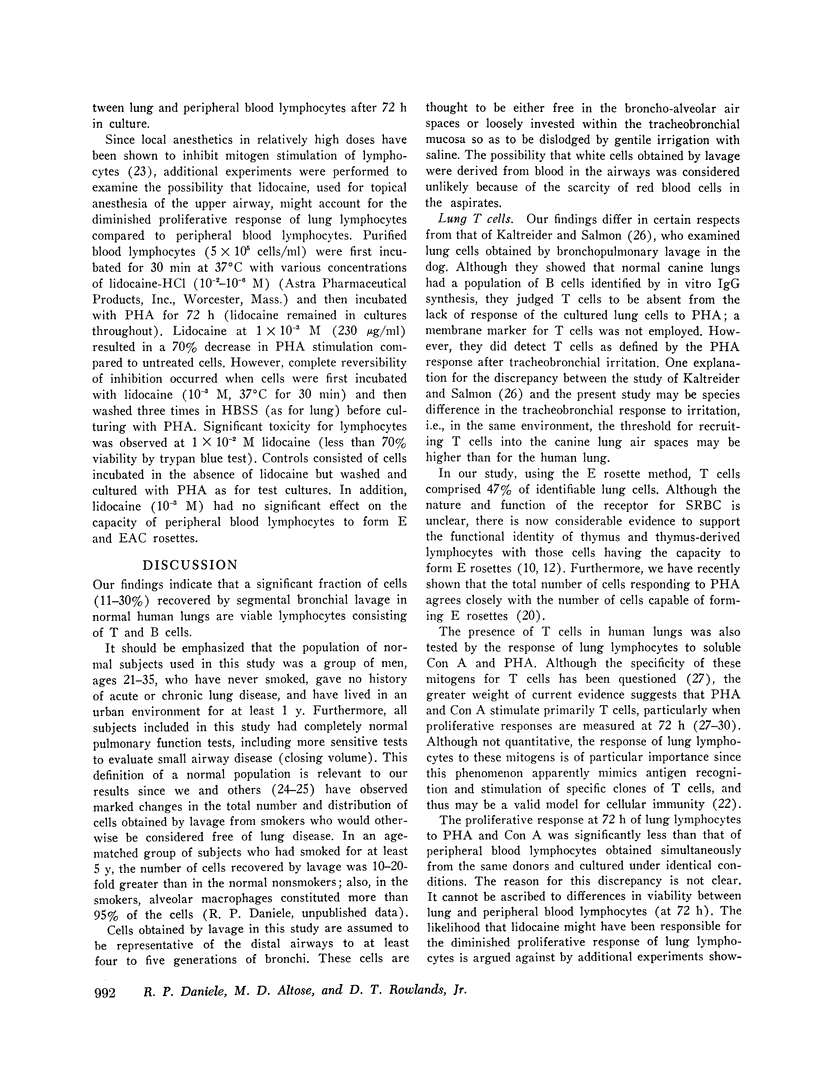
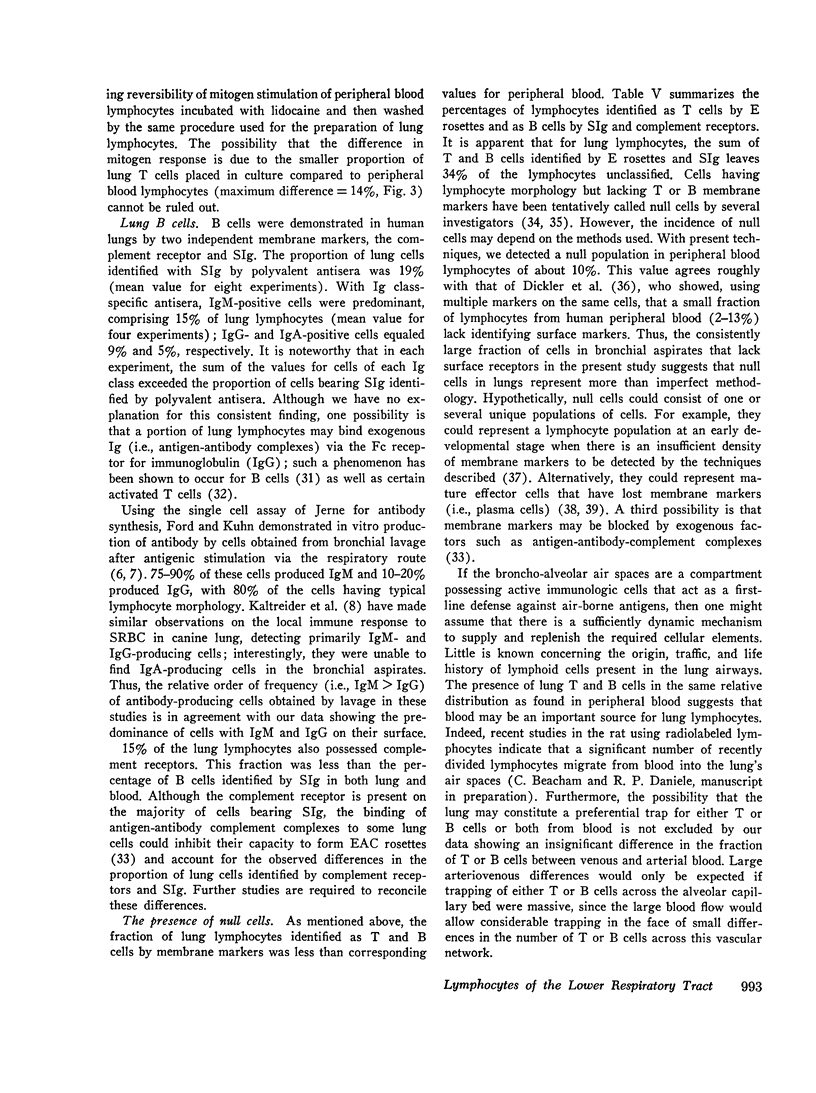
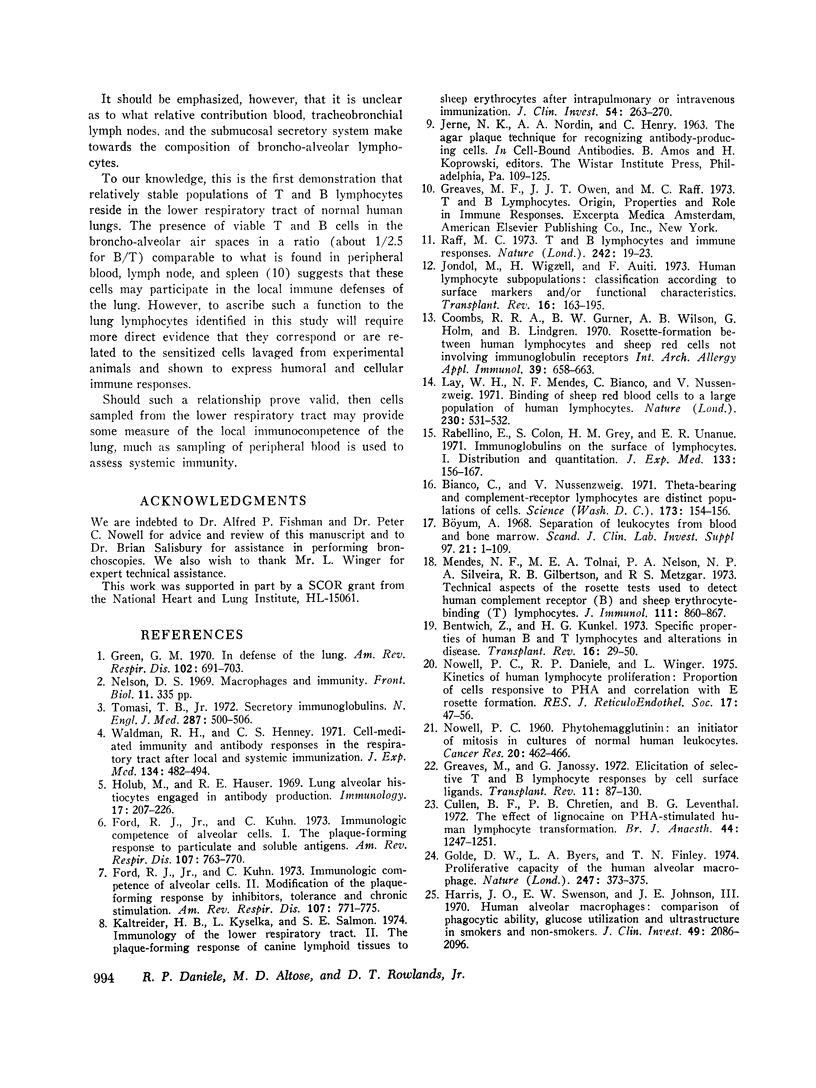
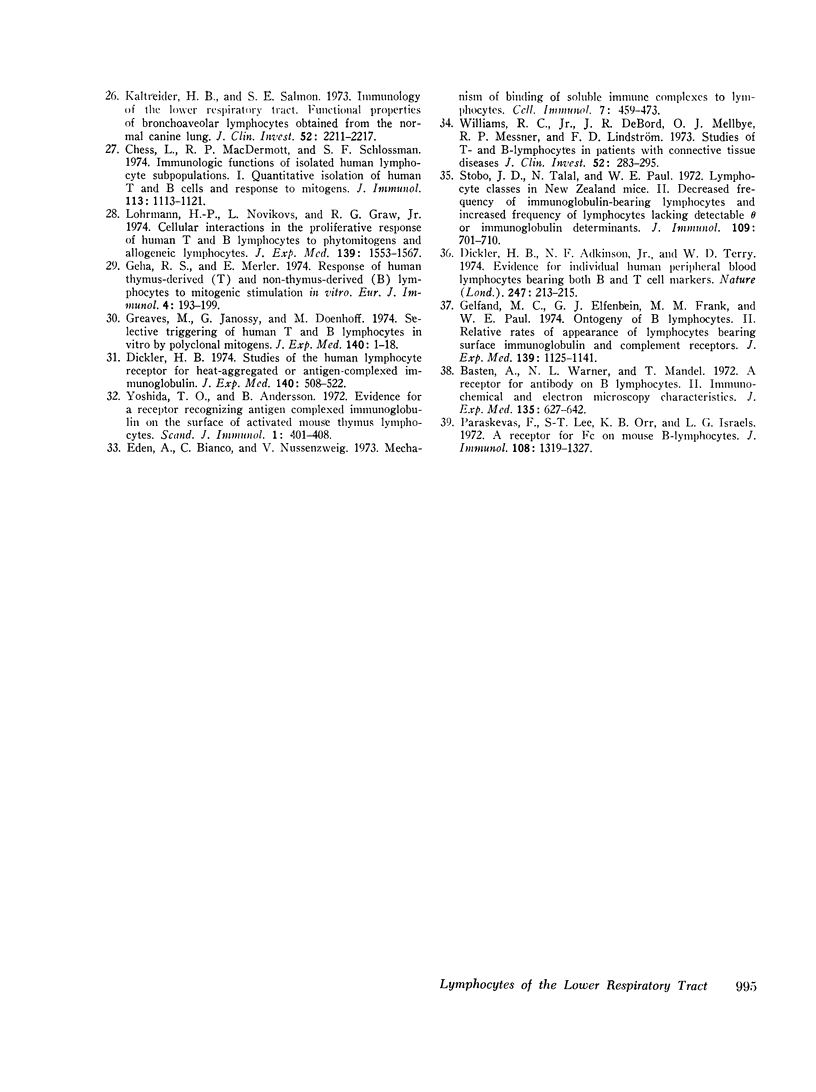
Images in this article
Selected References
These references are in PubMed. This may not be the complete list of references from this article.
- Basten A., Warner N. L., Mandel T. A receptor for antibody on B lymphocytes. II. Immunochemical and electron microscopy characteristics. J Exp Med. 1972 Mar 1;135(3):627–642. doi: 10.1084/jem.135.3.627. [DOI] [PMC free article] [PubMed] [Google Scholar]
- Bentwich Z., Kunkel H. G. Specific properties of human B and T lymphocytes and alterations in disease. Transplant Rev. 1973;16:29–50. doi: 10.1111/j.1600-065x.1973.tb00116.x. [DOI] [PubMed] [Google Scholar]
- Bianco C., Nussenzweig V. Theta-bearing and complement-receptor lymphocytes are distinct populations of cells. Science. 1971 Jul 9;173(3992):154–156. doi: 10.1126/science.173.3992.154. [DOI] [PubMed] [Google Scholar]
- Chess L., MacDermott R. P., Schlossman S. F. Immunologic functions of isolated human lymphocyte subpopulations. I. Quantitative isolation of human T and B cells and response to mitogens. J Immunol. 1974 Oct;113(4):1113–1121. [PubMed] [Google Scholar]
- Coombs R. R., Gurner B. W., Wilson A. B., Holm G., Lindgren B. Rosette-formation between human lymphocytes and sheep red cells not involving immunoglobulin receptors. Int Arch Allergy Appl Immunol. 1970;39(5-6):658–663. doi: 10.1159/000230390. [DOI] [PubMed] [Google Scholar]
- Cullen B. F., Chretien P. B., Leventhal B. G. The effect of lignocaine on PHA-stimulated human lymphocyte transformation. Br J Anaesth. 1972 Dec;44(12):1247–1252. doi: 10.1093/bja/44.12.1247. [DOI] [PubMed] [Google Scholar]
- Dickler H. B., Adkinson N. F., Jr, Terry W. D. Evidence for individual human peripheral blood lymphocytes bearing both B and T cell markers. Nature. 1974 Jan 25;247(5438):213–215. doi: 10.1038/247213a0. [DOI] [PubMed] [Google Scholar]
- Dickler H. B. Studies of the human lymphocyte receptor for heat-aggregated or antigen-complexed immunoglobulin. J Exp Med. 1974 Aug 1;140(2):508–522. doi: 10.1084/jem.140.2.508. [DOI] [PMC free article] [PubMed] [Google Scholar]
- Eden A., Bianco C., Nussenzweig Mechanism of binding of soluble immune complexes to lymphocytes. Cell Immunol. 1973 Jun;7(3):459–473. doi: 10.1016/0008-8749(73)90210-4. [DOI] [PubMed] [Google Scholar]
- Ford R. J., Jr, Kuhn C. Immunologic competence of alveolar cells. I. The plaque-forming response to particulate and soluble antigens. Am Rev Respir Dis. 1973 May;107(5):763–770. doi: 10.1164/arrd.1973.107.5.763. [DOI] [PubMed] [Google Scholar]
- Ford R. J., Jr, Kuhn C. Immunologic competence of alveolar cells. II. Modification of the plaque-forming response by inhibitors, tolerance, and chronic stimulation. Am Rev Respir Dis. 1973 May;107(5):771–775. doi: 10.1164/arrd.1973.107.5.771. [DOI] [PubMed] [Google Scholar]
- Geha R. S., Merler E. Response of human thymus-derived (T) and non-thymus-derived (B) lymphocytes to mitogenic stimulation in vitro. Eur J Immunol. 1974 Mar;4(3):193–199. doi: 10.1002/eji.1830040308. [DOI] [PubMed] [Google Scholar]
- Gelfand M. C., Elfenbein G. J., Frank M. M., Paul W. E. Ontogeny of B lymphocytes. II. Relative rates of appearance of lymphocytes bearing surface immunoglobulin and complement receptors. J Exp Med. 1974 May 1;139(5):1125–1141. doi: 10.1084/jem.139.5.1125. [DOI] [PMC free article] [PubMed] [Google Scholar]
- Golde D. W., Byers L. A., Finley T. N. Proliferative capacity of human alveolar macrophage. Nature. 1974 Feb 8;247(5440):373–375. doi: 10.1038/247373a0. [DOI] [PubMed] [Google Scholar]
- Greaves M., Janossy G., Doenhoff M. Selective triggering of human T and B lymphocytes in vitro by polyclonal mitogens. J Exp Med. 1974 Jul 1;140(1):1–18. doi: 10.1084/jem.140.1.1. [DOI] [PMC free article] [PubMed] [Google Scholar]
- Greaves M., Janossy G. Elicitation of selective T and B lymphocyte responses by cell surface binding ligands. Transplant Rev. 1972;11:87–130. doi: 10.1111/j.1600-065x.1972.tb00047.x. [DOI] [PubMed] [Google Scholar]
- Green G. M. The J. Burns Amberson Lecture--in defense of the lung. Am Rev Respir Dis. 1970 Nov;102(5):691–703. doi: 10.1164/arrd.1970.102.5.691. [DOI] [PubMed] [Google Scholar]
- Harris J. O., Swenson E. W., Johnson J. E., 3rd Human alveolar macrophages: comparison of phagocytic ability, glucose utilization, and ultrastructure in smokers and nonsmokers. J Clin Invest. 1970 Nov;49(11):2086–2096. doi: 10.1172/JCI106426. [DOI] [PMC free article] [PubMed] [Google Scholar]
- Holub M., Hauser R. E. Lung alveolar histiocytes engaged in antibody production. Immunology. 1969 Aug;17(2):207–226. [PMC free article] [PubMed] [Google Scholar]
- Jondal M., Wigzell H., Aiuti F. Human lymphocyte subpopulations: classification according to surface markers and-or functional characteristics. Transplant Rev. 1973;16:163–195. doi: 10.1111/j.1600-065x.1973.tb00120.x. [DOI] [PubMed] [Google Scholar]
- Kaltreider H. B., Kyselka L., Salmon S. E. Immunology of the lower respiratory tract. II. The plaque-forming response of canine lymphoid tissues to sheep erythrocytes after intrapulmonary or intravenous immunization. J Clin Invest. 1974 Aug;54(2):263–270. doi: 10.1172/JCI107761. [DOI] [PMC free article] [PubMed] [Google Scholar]
- Kaltreider H. B., Salmon S. E. Immunology of the lower respiratory tract. Functional properties of bronchoalveolar lymphocytes obtained from the normal canine lung. J Clin Invest. 1973 Sep;52(9):2211–2217. doi: 10.1172/JCI107406. [DOI] [PMC free article] [PubMed] [Google Scholar]
- Lay W. H., Mendes N. F., Bianco C., Nussenzweig V. Binding of sheep red blood cells to a large population of human lymphocytes. Nature. 1971 Apr 23;230(5295):531–532. doi: 10.1038/230531a0. [DOI] [PubMed] [Google Scholar]
- Lohrmann H. P., Novikovs L., Graw R. G., Jr Cellular interactions in the proliferative response of human T and B lymphocytes to phytomitogens and allogeneic lymphocytes. J Exp Med. 1974 Jun 1;139(6):1553–1567. doi: 10.1084/jem.139.6.1553. [DOI] [PMC free article] [PubMed] [Google Scholar]
- Mendes N. F., Tolnai M. E., Silveira N. P., Gilbertsen R. B., Metzgar R. S. Technical aspects of the rosette tests used to detect human complement receptor (B) and sheep erythrocyte-binding (T) lymphocytes. J Immunol. 1973 Sep;111(3):860–867. [PubMed] [Google Scholar]
- NOWELL P. C. Phytohemagglutinin: an initiator of mitosis in cultures of normal human leukocytes. Cancer Res. 1960 May;20:462–466. [PubMed] [Google Scholar]
- Nowell P. C., Daniele R. P., Winger L. A. Kinetics of human lymphocyte proliferation: proportion of cells responsive to phytohemagglutinin and correlation with E rosette formation. J Reticuloendothel Soc. 1975 Jan;17(1):47–56. [PubMed] [Google Scholar]
- Paraskevas F., Lee S. T., Orr K. B., Israels L. G. A receptor for Fc on mouse B-lymphocytes. J Immunol. 1972 May;108(5):1319–1327. [PubMed] [Google Scholar]
- Rabellino E., Colon S., Grey H. M., Unanue E. R. Immunoglobulins on the surface of lymphocytes. I. Distribution and quantitation. J Exp Med. 1971 Jan 1;133(1):156–167. doi: 10.1084/jem.133.1.156. [DOI] [PMC free article] [PubMed] [Google Scholar]
- Raff M. C. T and B lymphocytes and immune responses. Nature. 1973 Mar 2;242(5392):19–23. doi: 10.1038/242019a0. [DOI] [PubMed] [Google Scholar]
- Stobo J. D., Talal N., Paul W. E. Lymphocyte classes in New Zealand mice. II. Decreased frequency of immunoglobulin-bearing lymphocytes and increased frequency of lymphocytes lacking detectable theta or immunoglobulin determinants. J Immunol. 1972 Oct;109(4):701–710. [PubMed] [Google Scholar]
- Waldman R. H., Henney C. S. Cell-mediated immunity and antibody responses in the respiratory tract after local and systemic immunization. J Exp Med. 1971 Aug 1;134(2):482–494. doi: 10.1084/jem.134.2.482. [DOI] [PMC free article] [PubMed] [Google Scholar]
- Williams R. C., Jr, DeBoard J. R., Mellbye O. J., Messner R. P., Lindström F. D. Studies of T- and B-lymphocytes in patients with connective tissue diseases. J Clin Invest. 1973 Feb;52(2):283–295. doi: 10.1172/JCI107184. [DOI] [PMC free article] [PubMed] [Google Scholar]
- Yoshida T. O., Andersson B. Evidence for a receptor recognizing antigen complexed immunoglobulin on the surface of activated mouse thymus lymphocytes. Scand J Immunol. 1972;1(4):401–408. doi: 10.1111/j.1365-3083.1972.tb03306.x. [DOI] [PubMed] [Google Scholar]



